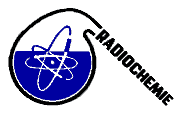Speaker
Mr
Stefan Söllradl
(Technische Universität München)
Description
Neutron Activation Analysis (NAA) is a well established method for non-destructive determination of elemental composition and the analysis of trace elements. Prompt Gamma Neutron Activation Analysis (PGAA or PGNAA) is a complementary radioanalytical technique to NAA for non-invasive investigations of samples with neutrons.
One of the main advantages of this latter technique is the easy determination of some light elements like H, Li, Be, B, C, N and S, that can not be easily determined or cannot be determined at all by NAA. Moreover, for the determination of elements like P, Cd, Gd and Pb PGAA is more effective thanks to the high neutron cross section of some isotopes that are not activated after the irradiation.
The next advantage of PGAA is the rapidity: the irradiation takes max. few hours, the data analysis can be performed on the day of measurement and the sample is not activated for a long time. Furthermore, the sample needs no preparation for the PGAA measurement.
At the first sight, the disadvantage of the PGAA to NAA are the detection limits. Compared to NAA they are usually higher, aside few exceptions, mainly in the ppm region. But speaking about PGAA, it is more correct to mention “dynamic detection limits” because they are strongly dependent on the matrix of the samples and on the background of the neutron beam (measurements are done during the sample’s irradiation).
The neutron beam guide NL4b at the research reactor Froschungsneutronenquelle Heinz Maier-Leibnitz (FRM II) in Garching bei München is dedicated to the new Prompt Gamma Neutron Activation Analysis facility.
The fingerprint of this PGAA instrument is the cold neutron flux of a very high intensity due to the elliptically tapered design of the neutron beam guide. The neutrons are focused at the sample position with a maximum thermal equivalent flux of 6.3*10^10 n/cm² s (1.7*10^10 n/cm² s using the measured mean energy of neutron spectrum, 1.83 meV). The detection system is made by two HPGe detectors, both with a standard Compton suppression system.
In this contribution few exemplary measurements of “typical PGAA elements” will be presented:
• Hydrogen is a very interesting element concerning superconducting materials and some clathrates. Its presence inside these compound can modify the material charachteristics;
• PGAA is very effective for the determination of boron. The dynamic range for this element was determined, as well as the detection limit and used for measurements in silicium wafers and nano-particles;
• 1-dimensional distribution of bismuth in lead crystals was also determined with very good statistics.
• Cadmium is another “good element” for this technique. It was analysed in some biological samples for medical research.
Primary authors
Ms
Lea Canella
(Technische Universität München)
Dr
Petra Kudejova
(Technische Universität München)
Mr
Stefan Söllradl
(Technische Universität München)
Co-author
Prof.
Andreas Türler
(Paul Scherrer Institut)

